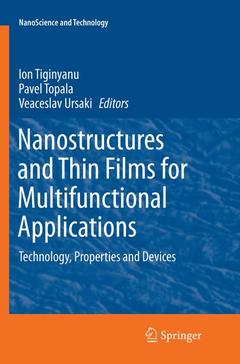Description
Nanostructures and Thin Films for Multifunctional Applications, 1st ed. 2016
Technology, Properties and Devices
NanoScience and Technology Series
Coordinators: Tiginyanu Ion, Topala Pavel, Ursaki Veaceslav
Language: English
Subject for Nanostructures and Thin Films for Multifunctional...:
Keywords
thin-film photovoltaics; photo-catalysis; nano-electronics; magnetic nanomaterials for spintronics; template-assisted nanotechnologies; oxide and hydroxide films; graphite films; ZnSxSe1-x thin films; A2B6 thin-film photovoltaic devices; magnetoelectric effects; semimagnetic semiconductors; diluted ferromagnetic alloy films; nanostructured and composite materials; photoluminescence of nanocomposites; formation of metal nanotubes; carbon nanomaterial THz devices
Publication date: 04-2018
Support: Print on demand
Publication date: 04-2016
Support: Print on demand
Description
/li>Contents
/li>Biography
/li>Comment
/li>
This book is focused on recent advances in the development of thin films for photovoltaic applications, TiO2/WO3 bi-layers for applications with enhanced photo-catalytic properties, nanometer oxide and hydroxide films for anticorrosive coatings, surface passivation in chemical industries, micro- and nanoelectronics, trilayers of metglas and lead free piezoelectrics for magnetic field sensors, current sensors, spintronics, microwave and read/write devices. Diluted ferromagnetic alloy films are also considered for superconducting spintronics based on superconducting spin-valves. Thermal properties of segmented nanowires are analyzed with respect to thermoelectric applications. Recent advances in template production of nanocomposites are also reviewed with particular focus on technologies for template assisted formation of metal nanotubes. Some elements related to abrasive flow machining (AFM), specifically state of the art elements of technological systems and construction of equipment are presented. The book is written for researchers in materials science, nanotechnologies, PhD students and graduate student.
The study of thin films by electrochemical impedance spectroscopy.- Nanometer oxide and hydroxide pellicles by applying electrical discharges in impulse (EDI).- Graphite films deposited on metal surface by electrical discharge pulse.- Structural and physical properties of ZnSxSe1-xthin films.- Thin-film photovoltaic devices based on A2B6compounds.- Theory of the anisotropic magnetoelectric effects in metglas-piezocrystal laminates.- Experimental studies of the direct and converse magnetoelectric effects in metglas-piezocrystal laminates.- Particularities of physical properties of semimagnetic semiconductors and their practical application.- Cobalt/cobaltoxide exchange bias system for diluted ferromagnetic alloy films in superconducting spin-valves.- Local ordering at the interface of the TiO2-WO3bi-layers.- Crystalline structure and surface morphology of AIIIBVI type lamellar semiconductor nanocomposites obtained by heat treatment in Cd and Zn vapor.- Optical and photoelectrical properties of GaS, GaSe, GaTe and InSe semiconductors and nanocomposites obtained by heat treatment in Cd and Zn vapor.- Photoluminescence of nanocomposites obtained by heat treatment of GaS, GaSe, GaTe and InSe single crystals in Cd and Zn vapor.- Nanoreliefs obtained by various manufacturing methods.- Template assisted formation of metal nanotubes.- Thermal conductivity of segmented nanowires.- THz devices based on carbon nanomaterials.- Abrasive flow machining.
Ion Tiginyanu received his M.S. degree from the Moscow Institute of Physics and Engineering in 1978. He received his Ph.D. degree in Semiconductor Physics from Lebedev Institute of Physics, Academy of Sciences of U.S.S.R., in 1982, and his Doctor habilitate degree in 1991 from the Institute of Applied Physics of the Academy of Sciences of Moldova. He became full professor in 1993 at the Technical University of Moldova. From 1984 to 1998 he worked as senior researcher at the Institute of Applied Physics of the Academy of Sciences of Moldova. In 1998 he joined the Technical University of Moldova, being appointed vice-Rector, while in October 2004 he was elected vice-president of the Academy of Sciences of Moldova. He serves as Director of the National Center for Materials Study and Testing and Professor at the Chair of Microelectronics of the Technical University of Moldova. In 1995–96 and 1998-99 he has been a visiting professor at the Institute of High-Frequency Electronics of the Technical University Darmstadt, Germany, while in 2001 - at the Department of Electrical Engineering and Computer Science of the University of Michigan, USA. In March 2013 he was elected first vice-president of the Academy of Sciences of Moldova. Professor Tiginyanu’s research interests are related to nanotechnologies, 3D hybrid nanomaterials, ultrathin membranes, photonic crystals, random lasing, cost-effective solar cells and new sensor technologies. He has more than 300 journal publications and 52 technological patents, and edited 5 books in English. His personal Hirsch index equals 31. In 2011 he got the ‘Outstanding Inventor’ Award from the World Intellectual Property Organization. Along with this, over the last decade he received 17 Gold and Silver Awards at the International Exhibition “Eureka” (Brussels), International Exhibition of Inventions in Geneva and at the International Exhibition of Inventions and New Products in Pittsburgh (USA). He is member of the
Highlights recent advances in the development of thin films, nanostructured and
nanocomposite materials
types of sensors, transducers, optoelectronic, thermoelectric, photonic,
spintronic, microwave and THz devices
Gives information about the development of two-dimensional carbon nanomaterials
Elucidates the prospects for covering the famous THz gap
Includes supplementary material: sn.pub/extras




